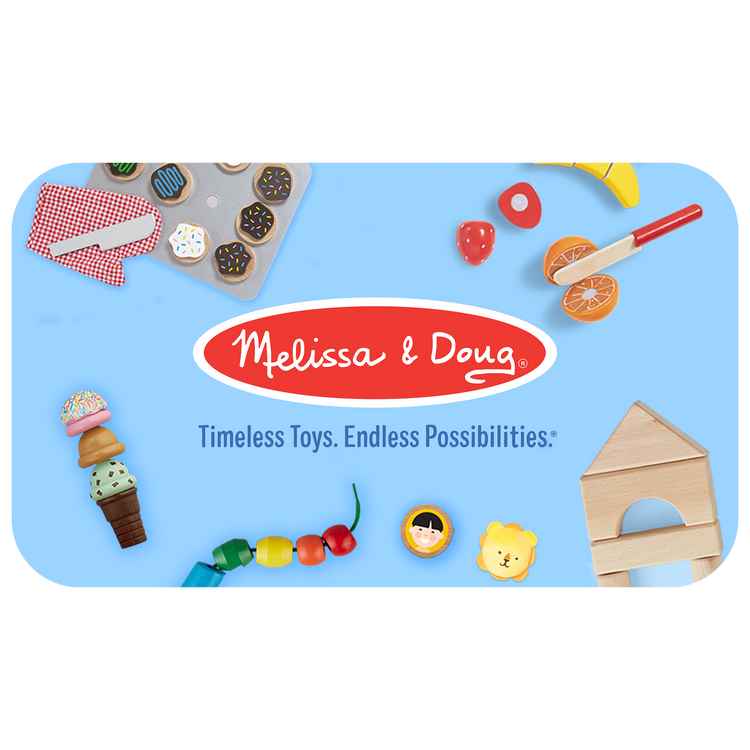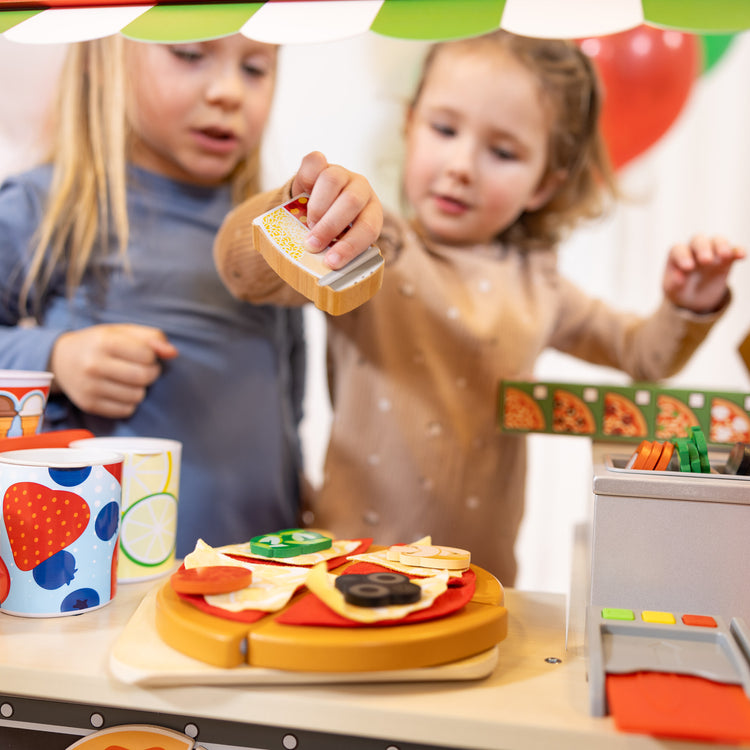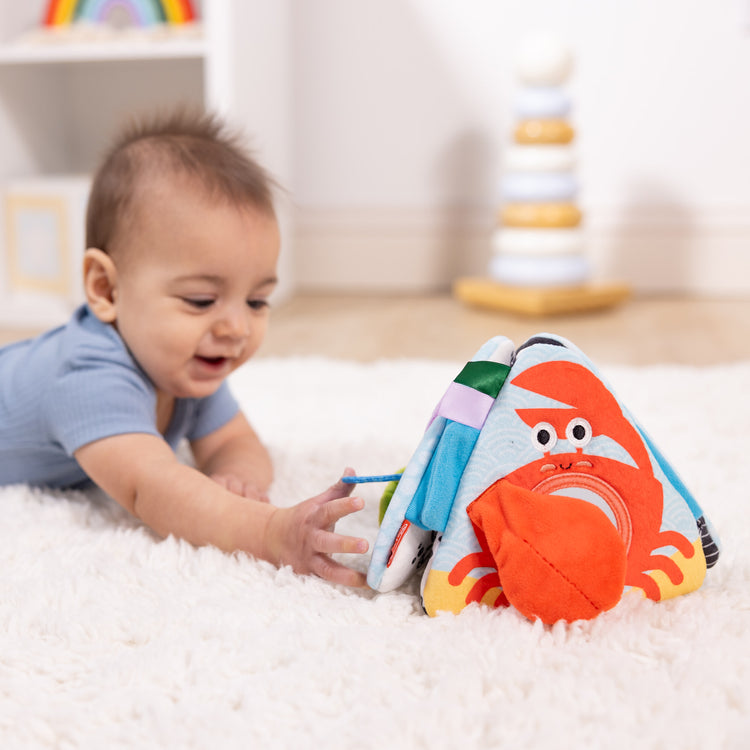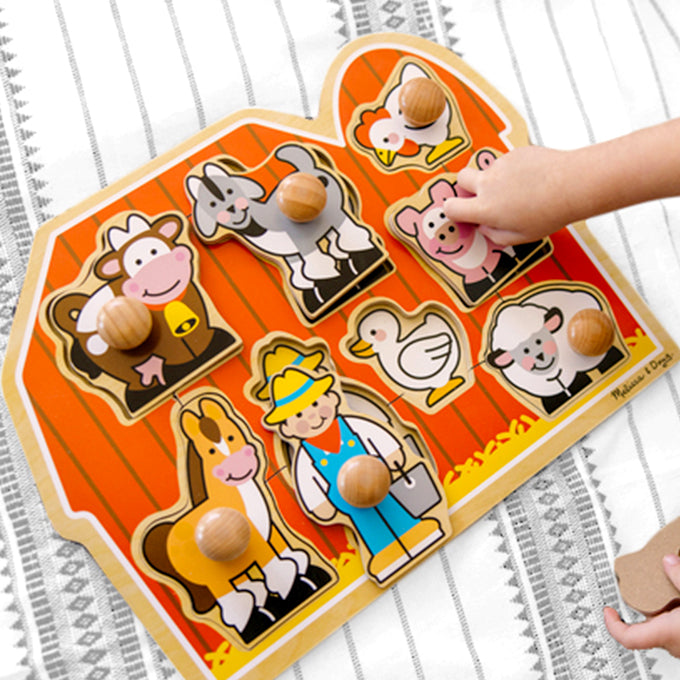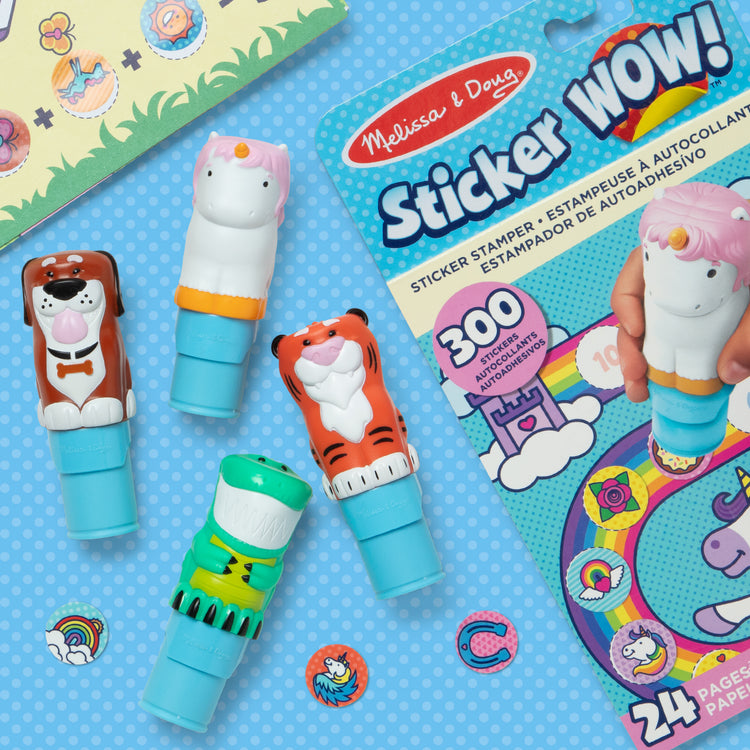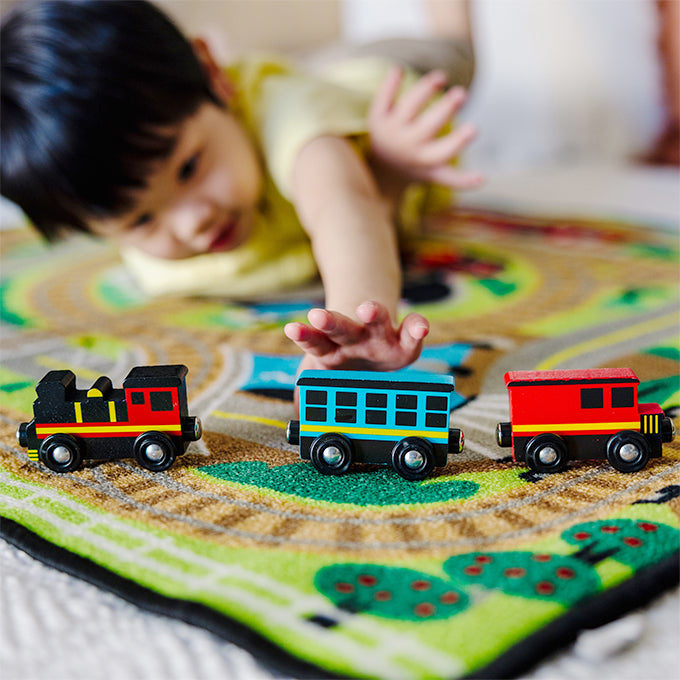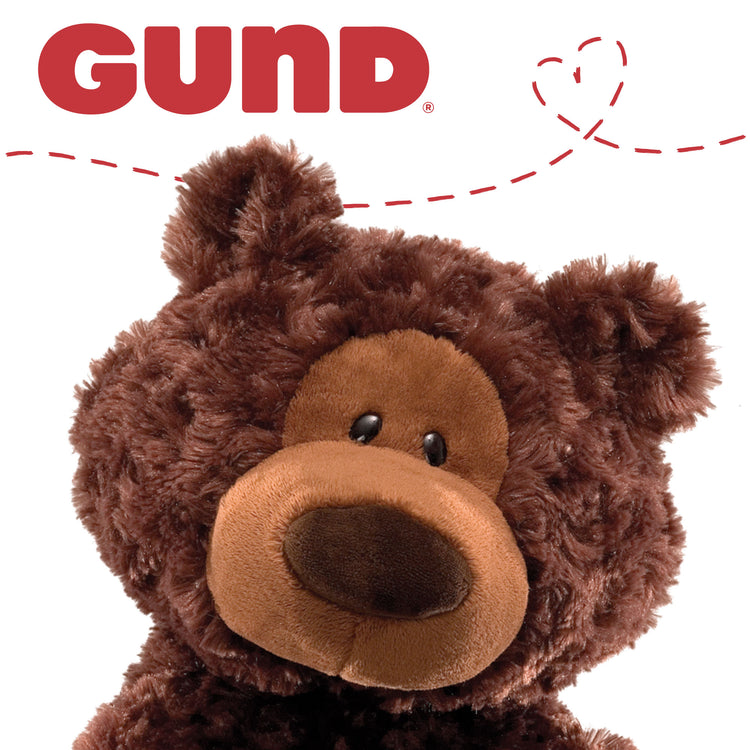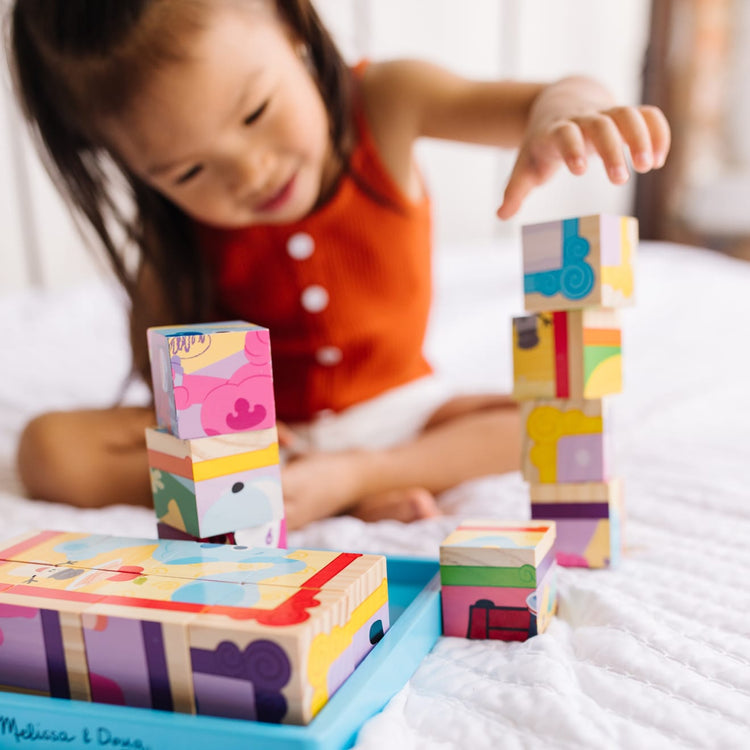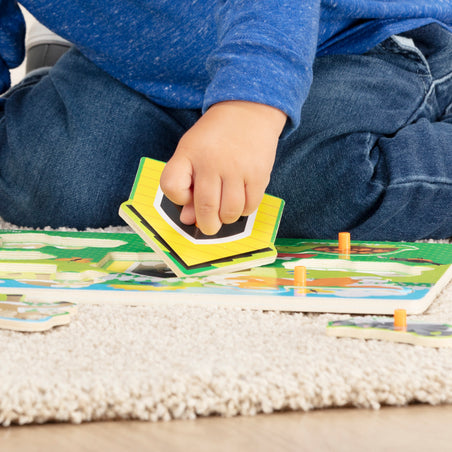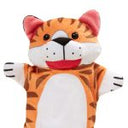Just in time for National Puzzle Day on January 29, our friend and blog contributor Kristi Nguyen, OTR/L, a licensed occupational therapist who’s the owner/executive director of Connecticut-based OT-Kids, LLC, shares a personal story about her family’s love for puzzles, and how she incorporates Melissa & Doug puzzles into her work!
10 Ways to Play With Puzzles
While sometimes it's fun to just sit at a table to complete a puzzle, I encourage you to find new ways to make puzzles a part of your child’s play! Here is a list of fun modifications that make puzzles more multi-sensory, and are sure to keep your children engaged from start to finish:
- Puzzle Hide & Seek: Using any of the chunky, knob or peg puzzles, hide puzzle pieces in a bucket of dry rice or beans and have your child dig through to find the missing pieces. Put a blindfold on your child and have them dig through the rice or beans to find all of the puzzle pieces before taking off the blindfold to put them into the puzzle. This is a great activity to improve tactile discrimination, as they will have to differentiate the puzzle pieces from the rice with only their sense of touch.
- Guess the Piece: To add a cognitive challenge, give your child clues as to what puzzle piece you are thinking of before they put it in the puzzle board. For example, “I am thinking of a vehicle that has a siren, a ladder and hose on it,” or, “I'm thinking of an animal that likes to swing in the trees and eat bananas.”
- Get Physical with Puzzles: Place the puzzle pieces on one side of the living room and the board on the opposite side. Have the child log roll or animal walk back and forth to place the pieces where they belong. “Can you hop like a frog to get the blue circle?”
- Build an Obstacle Course where the children have to jump (from tile to tile, or couch cushion to couch cushion), crawl (through a tunnel or under dining room chairs), balance (walk over a balance beam or a series of books placed on the floor or use painters tape on the floor), and climb (up a jungle gym or other sturdy furniture) before placing their puzzle piece.
- Sound Puzzle Game: Using any of the sound puzzles, put a blindfold on your child and put one of the pieces into the puzzle. Have the child guess which piece you placed in using nothing but their sense of hearing.
- Practice Shapes, Letters & Numbers: To encourage handwriting or drawing skills, have a white board or a piece of paper available. Have the child put a piece of the shape puzzle, letter puzzle, or number puzzle into the board and then draw that shape letter or number on the white board.
- Invisible Touch: Using your pointer finger, draw a shape or letter on the child's back or forearm (their eyes should be closed) on top of their clothing or directly on their skin. Have them guess what you drew, and then find that puzzle piece and put it in.
- Puzzle Scavenger Hunt: With large floor puzzles, hide the pieces around your yard or home and send your child out on an expedition to find the pieces and bring them back to “home base” to build the puzzle.
- Balance Challenge: If you have a balance beam or a tunnel, put all of the pieces on one side and the board on the other side so the child has to crawl or balance back and forth to complete the puzzle.
- Magnet Mix-Up: Using the Take Along Magnetic Jigsaw Puzzle, stick all of the pieces to your refrigerator or other magnetic surface and scramble them all up and place them all over the surface of the fridge to encourage the child to have to reach up high and squat down low to get the pieces.
- Bonus Idea: Simply change your child's position by having them work on puzzles while laying on their belly or kneeling in a tall kneel rather than sitting in a chair.
Why an Occupational Therapist Recommends Puzzle Play for Kids
We have a tradition in our family that has become one of the things I look forward to the most during the cold winter months here in New England.
Each Christmas, I buy a 1,000-piece puzzle, wrap it up with a fancy bow, and place it under the tree, addressed to my entire family. While some people in the Northeast head south during winter, my family spends our weekends visiting my parents in Vermont for snow and skiing fun.
When the mountain closes and the sun goes down each day, we head to my parents’ home where we have large family dinners, play board games and watch movies in front of the roaring fireplace. And every winter, we set up a folding card table where we sit around for hours working together (or sometimes NOT working so well together) in a race to get all 1,000 pieces of our annual puzzle in place before the last of the snow melts and our weekly trips to Vermont come to an end.
What started as a last-minute Christmas gift about 10 years ago has become one of our most loved traditions, and a challenge we look forward to embarking on each winter. I relish the fact that this one simple activity captivates everyone that walks through the door and finds themselves at that card table at least once to try and successfully place one tiny piece so they can say they contributed to the annual family puzzle.
Puzzle Play Development By Age
Puzzles are one of the few activities that truly interests and benefits people across their lifespan. I challenge you to find a preschool classroom that does not have at least a couple of puzzles, or a nursing home or retirement community where jigsaw puzzles are commonly used to help maintain or improve cognition, fine motor skills, or simply as a means of socializing during an afternoon gathering.
Puzzles are commonly found in the break room of cutting-edge businesses as an option for relaxation or socialization amongst staff, and during the months where we found ourselves quarantined to our homes last year, it was not uncommon for me to log on to social media and see pictures posted by my friends of their families’ latest puzzle success.
As an occupational therapist, I can tell you from first-hand experience the value of using puzzles in my practice extends far beyond basic enjoyment or the benefits of socialization. At my offices, we have shelves full of Melissa & Doug puzzles! We love Melissa & Doug puzzles because they come in such a variety, there is a puzzle for virtually each skill we would want to work on with our patients.
Puzzles for 1-Year-Olds, 2-Year-Olds, and 3-Year-Olds
With our toddlers and youngest kiddos (ages 1-3), we often reach for the chunky puzzles or jumbo knob puzzles with bright colorful pictures of shapes, animals or vehicles.
These types of puzzles not only support the development of language and vocabulary (“Can you find the animal that lives on the farm and says moo?”), but also the development and refinement of grasp patterns and fine motor skills in the tiny hands of our littlest patients. The chunky puzzles and jumbo knob puzzles have matching pictures on the boards that help toddlers develop spatial awareness, matching skills, problem solving, visual perception, direction following, and spatial organization. For this age, some of my favorite puzzles are the First Shapes Jumbo Knob Puzzle, Farm Animal Jumbo Knob Puzzle and all of the chunky puzzles.
Puzzles for 3-Year-Olds, 4-Year-Olds, and 5-Year-Olds

With our early childhood kiddos (ages 3-5), we love using the small peg inset puzzles with sound, magnetic puzzle games, and a personal favorite of mine, the floor puzzles!
At this age, some of my favorite recommended puzzles include any of the take-along magnetic puzzle games, the Dinosaur Floor Puzzle and Solar System Floor Puzzle, and my very favorite Melissa & Doug puzzle, The Alphabet Sound Puzzle. This is my favorite puzzle because not only does it encourage fine motor skills and visual perception skills, it also helps support preschool and school-aged children in development of letter recognition and phonetic awareness, which are critical skills for the development for later reading and writing.
As OTs, we are always looking for ways to modify an activity to make it more multi-sensory and more engaging for the child. Some ideas:
-
Hide puzzle pieces in a bucket of rice or beans, and encourage the child to dig through it to find the hidden pieces. We love taking out the giant floor puzzles and hiding the pieces around the room to have the children find them while propelling a scooter or crawling through a series of tunnels.
-
Turn a puzzle into a gross motor game by building an obstacle course for the children to navigate through as they work to build the puzzle piece by piece, while simultaneously improving their balance, coordination and motor planning skills.
Puzzles for 5-Year-Olds and Up

For our older, school-aged kiddos (ages 5 and older), we love to add in cognition and perceptual challenges during puzzle play. Some ideas:
- Scramble puzzle pieces. Take the wooden puzzles in a box that has four separate puzzles and scramble all of the pieces together to have the children find, sort, and turn one pile of pieces into four individual puzzles.
- Play with puzzle posture. We might challenge the child's postural system by having them sit in a tall kneel to complete the puzzle rather than sitting in a chair or on the floor, or have them balance on an inflatable surface while engaging in a puzzle activity.
- Make up magnetic challenges. We might take pieces from the Take Along Magnetic Jigsaw Puzzle line and stick them up high on our magnetic rock climbing wall to have the children climb to find the pieces.
For older children, some of my favorite puzzles are the USA Map Floor Puzzle, all of the Wooden Puzzles in a Box, and the entire line of Take Along Magnetic Jigsaw Puzzles.
The Developmental Benefits of Puzzle Play

There are plenty of benefits of using puzzle play for children of all ages. We use puzzles for the development of fine motor skills, visual motor and visual perception skills, cognition, eye- hand coordination, spatial awareness, and so much more. Let’s take a look at some of the key developmental areas we can improve through puzzle play.
Cognition: From our very earliest years as an infant or toddler, our minds seek out opportunities to solve problems and learn. We manipulate items with our hands to learn about how they are used, how they work, and how two things go together.
Puzzles that introduce shapes and colors provide the youngest children with basic understanding of commonly used vocabulary.
As OTs, we use a child's cognitive and developmental level to grade our challenges for children. One child might be required only to match the animals to complete a puzzle (“Can you show me where the dog goes?”), where another child might get an added cognitive challenge such as, “Can you find the animal that says woof and put it in the puzzle?” Or even more challenging, “Can you find the animal that wags its tail and likes to play with bones?” As children continue to age, we stop using inset puzzles and transition to large-piece floor puzzles and smaller wooden jigsaw puzzles of increasing piece counts.
Fine Motor Development: Developing the muscles of the hands and fingers begins as we are born. Infants explore the world through their hands and fingers, reaching for and grasping anything they put their eyes on. This is why starting with large chunky and knob puzzles is important for our youngest kiddos. Keeping in mind that anything in their hands will likely find its way to the mouth is important for obvious safety reasons, but these larger puzzle pieces also help infants, toddlers and growing children manipulate, grasp, and hold developmentally appropriate-sized puzzle pieces.
Toddlers will begin to use more refined grasp-and-pinch patterns, perfect for picking up and placing a knob puzzle. As the child ages and develops more precise use of their hands and fingers, they will transition to smaller pieces with a peg on top that requires a pinch. Eventually, we transition to jigsaw puzzles that require a pincer grasp to pick up and manipulate to properly align and orient the piece prior to putting it in place. Magnetic puzzles allow us to work on a vertical surface, which adds more value to the activity and allows us to present the task in a number of different positions and orientations to achieve our goal for a specific child.
Spatial Awareness: Being able to properly orient a puzzle piece to set it in the right spot and make it fit securely is a skill that challenges developing bodies. For babies and toddlers, this might mean placing a large chunky circle into the round spot on the puzzle board. This doesn’t require much skill, as the circle will fit in place no matter how it is oriented. However, as children age and we begin to use puzzles with less consistent shapes, turning and orienting the puzzle piece becomes a crucial part of successfully placing a piece. In order to make the dog fit into its place the child must be sure to orient that dog correctly so that the paws are at the bottom and the dog is facing the right direction. This is called spatial awareness. The child will quickly learn that if the dog is not oriented correctly, the puzzle piece will not sit in its place correctly. The child must first manipulate the dog to be sure it is oriented correctly. This is teaching the child spatial awareness and eye-hand coordination.
As a child ages and we begin to introduce jigsaw puzzles, we teach them to locate the edge or border pieces first. This helps the child understand space as it provides a border or outline from which to work. The child must find all of the pieces that have a straight edge and then determine how all of those edge pieces connect to create the border. Once the border is completed, the child then uses their spatial awareness to finish the rest of the puzzle.
Sensory Discrimination: One of the things that I love most about Melissa & Doug’s line of puzzles is the different sensory experiences we can integrate into our activities using them. Some of the puzzles have tactile differences; for instance, the puzzle pieces might be textured. But the feature that I love and use the most is the auditory feature on the sound puzzles. Using sound to help children discriminate and learn helps provide a multi-sensory experience to even the most simple of activities.
Pairing the sound that an animal makes with a picture of the animal allows us to differentiate each activity based on what specific skill a child is working on. Occasionally we have a child that is not ready to have a puzzle with sounds, so we can simply take the batteries out and use the same puzzle in a different manner.

